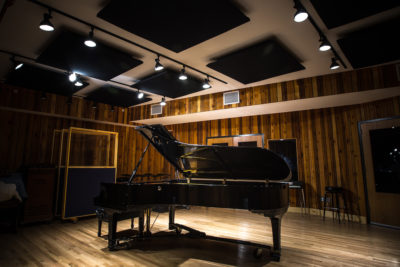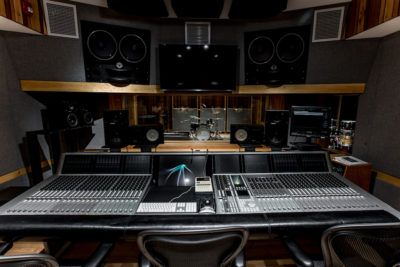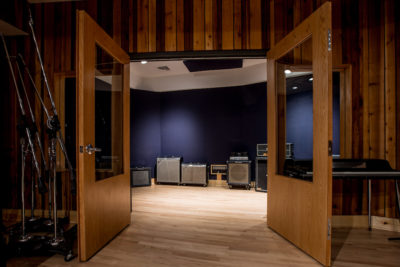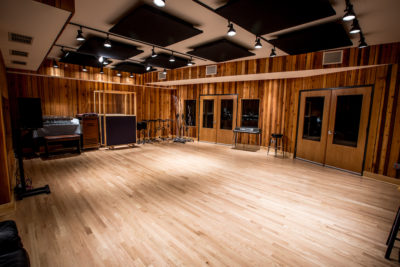The Return of Sound on Sound Studios: An NYC Legend Moves to Montclair, NJ
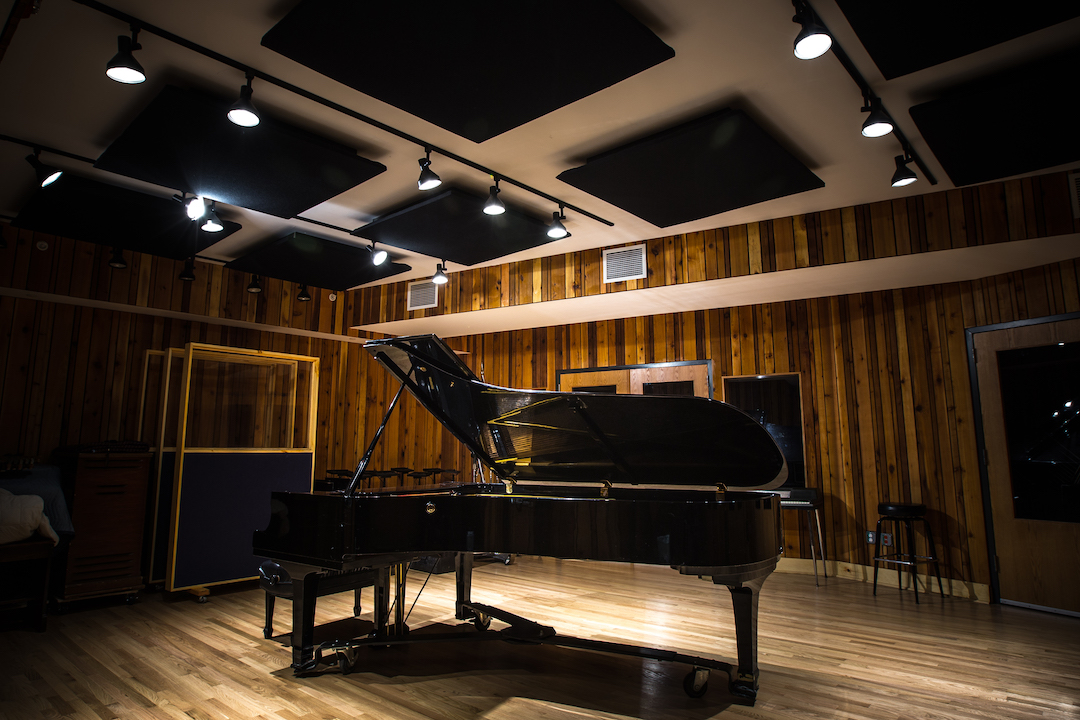
Sound On Sound, a legend of the NYC studio scene has returned, now 30 minutes across the Hudson River in Montclair, NJ.
I recently took a stretch of road less traveled to see an old friend, Tony Drootin, as he oversaw construction on David Amlen’s latest studio, the newly reborn Sound on Sound now in Montclair, NJ.
Both Amlen and Drootin were key players in the NYC studio scene during its last great peak, with Amlen serving as president of SPARS and owner of the original Sound on Sound, MSR, and Legacy, and Drootin acting as a longtime manager for a handful of major Manhattan studios including Unique, Sony, Daddy’s House, and Platinum Sound.
The scene in Manhattan has both changed and shrunk since then, necessitating a change of venue for both. But some things never seem to change: The two still appeared to be considering every little detail you could think in building this new facility.
Construction was in full swing as I visited, and it quickly became obvious that great care was being taken to the ensure the kind of quality, functionality, and aesthetics a one would expect of a studio centered in one of the music capitals of the world—never mind that we were 30 minutes and a river away from their old stomping grounds.
A quick walkthrough reveals two studios, designed with recording foremost in mind.
Studio A was built to feature a 72-input Neve VR console with Musgrave modifications.
The main monitors there are Augspurger 3 ways. There are 96 channels of I/O to go along with a large studio surrounded by 4 isolation booths all with clear lines of sight.
“You could put a choir and backing band in here and track it live,” Drootin says as we enter the studio. Throw in the 9’ Yamaha concert grand and I’m immediately sold on the space.
Studio B features a 6-card Euphonix System 5 console with 128 channels of I/O. This room has two iso booths, and is a perfect size for small bands and overdubs.
Of course, along with these rooms comes a collection of microphones, signal processors, drums, vintage amps, and a Hammond C3 that one feels like they never left the golden age of Manhattan studios behind.
I asked the two a bit more about their goals for this new pair of studios, and what brought them to this point.
Dave, what have you been doing since you closed MSR Studios? What did you do following the studio’s closure, and how did that lead to initiating Sound on Sound Studios in New Jersey?
During the closure of MSR, I was in negotiations with several parties to both open a new facility in midtown New York City, and to [potentially] purchase Avatar studios with partners.
After months of negotiations that ultimately ended without signed deals, I started to seriously consider NJ.
I was in discussions with the former mayor of Montclair, who happens to be a friend I met through a non-profit. He introduced me to several developers in the area, and this ultimately led me to my current location. Sound on Sound in New Jersey has been in the design and build-out process since April of this year.
Tony, the last time we spoke with you, you were the manager for Platinum Sound. What was the sequence of events that led you to teaming up with Dave on this facility?
Dave and I have stayed in touch over the years. We spoke on a regular basis when the original Sound on Sound Studios was in operation on West 45th Street, and while I was the director of operations at Sony Music Studios on West 54th.
While I was managing Daddy’s House studios for Sean Combs, Dave and I were out to lunch one day and he asked if I’d be willing to come on board as manager of MSR Studios on 48th Street. Though honored, I declined as I was already committed to another client in New Jersey and Miami developing a recording and performance business.
We left off with the knowledge that someday we would work together. Fast forward a bit, and we spoke regarding his desire not to reopen in New York and the possibility of my coming on board to manage the place. I eventually left Platinum to pursue another opportunity. Less than a year after, the stars lined up, and I enthusiastically jumped on board.
Tony, describe the opportunity you see for a large-scale studio in New Jersey. What are the advantages you saw in opening in Montclair, specifically?
There were a number of reasons Dave decided on Montclair and I wholeheartedly agreed. First, it was close enough to the city to allow clients to access the facility. Secondly, Montclair is an amazing town. It is diverse, has a robust artist community, and has a great selection of restaurants, bars, and music venues. In addition, we are building relations with nearby William Patterson University and Montclair University.
Dave looked at many possible locations, but the footprint of the real estate was the clincher. It allowed for the building of two great live tracking spaces. We certainly can and want to attract pop, R&B, and urban clients as well. However, the tracking spaces we built allow for bands, large and small ensemble work, events, performances and much more.
We both feel there is a tremendous opportunity here in New Jersey. Both Dave and I have years of experience in operating large, high-profile, commercial studio operations. We are bringing what we feel will be the first of these types of facilities to New Jersey. There is a huge music community on this side of the Hudson River and Montclair is home to a great community of artists in itself.
The cost of going into the city and the hassle is making it very unattractive for many. Let’s face it—the New York scene has changed. The feedback we are getting is overwhelmingly positive and similar: New Jersey needed this. Clients are excited we will make it possible to no longer have to go into Manhattan, and will be saving them on tolls and parking.
The obvious advantage is the cost of real estate. More and more businesses are being pushed out of Midtown, which historically has been where most of the large format recording facilities have been located over the years. Plain and simple, it is becoming cost prohibitive to operate a commercial studio—and many others businesses as well—in midtown Manhattan. A number of other established businesses are about to come to the end of their lease terms and are going to feel the sting of drastic increases in their per-square-foot cost.
By starting this foothold in New Jersey, it afforded us the ability to create large tracking spaces that would be too expensive and difficult to find space for in the city. Our small tracking space, Studio B, has almost 600 square feet of live recording space with two isolation booths. This B-room alone is bigger than most A-rooms in the city. Our larger live tracking space, Studio A, is over 1,200 square feet with four isolation booths.
Not to mention free parking. We are three blocks from the New Jersey transit train and the commute is under 30 minutes, which is less than a trip to Brooklyn from midtown. Our choice of Montclair was purposeful. The town has over 100 restaurants, a college, and a robust music and film community. We are two blocks from the Wellmont Theater.
Dave, this new Sound on Sound Studios is located in a former car dealership. What were your original criteria for a building, and what made this site the best match for your vision?
I looked at many buildings in the area, both for purchase and rental. After crunching numbers, I realized that unless I planned to be in a certain location for more than twenty years, the cost of purchase made little to no sense.
For a sound studio, certain requirements are more important than others. I wanted a building with steel framing and concrete flooring as this minimizes both direct transmission of sound from floor to floor and low frequency coupling throughout the building.
The original Sound On Sound on 45th Street in Manhattan was in such a building whereas MSR [formerly Right Track and Legacy] on 48th Street was in a wood frame, wood floor building, and we were always fighting room-to-room and adjacent tenant noise issues.
The new location in Montclair was previously a Cadillac dealership and designed to have full size cars serviced on both levels at any given time. The floors are more than 12” thick concrete throughout the building.
Other major factors in deciding on this location include ample on-site parking and proximity to various forms of public transportation into NYC, including bus and train. Montclair is 12 miles to midtown Manhattan. Another huge asset is the town itself, which has over 100 restaurants catering to almost every taste and type of food.
George Augspurger did the acoustical design. Dave, what was your prior relationship with George, and how would you characterize is designs?
I have known George for almost 25 years, dating back to control room updates I did at Sound On Sound using his custom speaker designs. He also came in and made some suggestions to improve the acoustics of both control rooms. The response from clients was incredible, and both of the Sound On Sound studios became major mix rooms within the industry.
I did the initial design for the new studios and consulted with a local architect before bringing George on as an acoustic consultant. He refined my design and made various suggestions for construction techniques to minimize room-to-room sound leakage as well as designs for various acoustic panels throughout the control rooms, studios, and iso booths.
Can you tell us a little more about the design goals of the rest of the space, and the gear you chose?
This is my take on the modern studio, incorporating the best of the old with the best of the new.
During the past five years I noticed, with very few exceptions, most of the classic outboard equipment was not used. Clients needed good front end equipment—microphones and mic preamps—for pristine recordings during tracking, but did not need or use racks of outboard equipment, rarely taking advantage of any of the many racks of outboard gear we had at MSR. They also needed extensive plugins during mixing sessions.
I did listening tests, along with other engineers and producers of note, comparing various high end plugins with the original equipment on which they were based, and concluded that the differences were minimal, at best. I upgraded both ProTools systems, upgraded our extensive plugin list, which is identical for both studios, and also replaced all the converters in both systems.
Both consoles are designed for tracking and mixing. I kept certain key pieces of outboard gear, which offer additional sonic flavors during both tracking and mixing sessions as well as allowing for quick vocal or other overdub session without needing to configure plugins or auxiliary cue mixes.
When did construction begin? And have there been any surprises along the way?
We began construction and renovation in late May and finished everything other than wiring and acoustic treatments during the middle of September. Throughout the last few weeks, we have been concentrating on wiring, equipment testing, and finishing acoustic treatments. With any major facility, there are always surprises but as I was on site every day supervising the buildout. Issues were dealt with on the spot and rectified within a day or two, at most.
Tony, how is the studio being staffed? Will there be full-time engineers or other employees there?
Dave will be chief engineer, myself the manager, we will have a number of assistant engineers who have worked with us over the years and are already on board.
We are developing relations with the local schools and other learning institutions to build a robust intern program. Interns are the farm team of any great facility. We believe in developing and promoting from within.
Other than Dave, there will not be any staff engineers—at least initially. Of course like every other facility, we will nurture existing and develop new relationships with as many engineers as we can. Many have already visited and showed their support.
Tony, how do you expect the studio’s clientele will grow from here?
Dave and myself have more than 60 years of combined contacts and relations to our advantage and the feedback thus far has been tremendous. People are extremely excited and supportive. We have already had a variety of engineers, producers, and artists reaching out and visiting the space.
Our job is to spread the word to our network of existing clients, then make sure others know we are here and will treat them with 5-star service. Of course trade write ups, social media, emails, and hard calls are all necessary, but once clients see what we have to offer we believe the facility will sell itself.
You said “Anyone can build a studio, but that doesn’t mean you know how to run a studio.” What do you mean by that?
Chris Lord Alge told me early on in my career, “All studios have a console, speakers and a tape machine. The one with the best coffee wins”.
He was right. It’s all about the clients. Studios are hotels, and it is a competition to attract the most guests. Running a studio is all about the marriage of technical capability, operations, facility management and an eye for client comfort. The studio has to work, sound good, and look good. The staff has to be well-trained and know good studio etiquette. The artist has to be comfortable and trust the staff will be discreet. The client has to get a session report and an invoice, and know their content is safe and delivered properly and labeled correctly, and so on.
You might be a great engineer, own a studio, but maybe you never did payroll, worked in Quickbooks, or lead a team. Or, you might have great business sense but don’t understand artists and their needs. Running a studio is an art form in itself. It is a combination of many things, and doing it right is a team effort.
Dave, you have fought many battles throughout your decades of recording studio ownership. What have you learned from your past experiences at Sound on Sound NYC, Legacy and MSR that best prepare you for Sound on Sound Studios?
Obviously not enough to not do this again!
Seriously, the past thirty years have been a constant learning process for me. I looked forward to going to work every day for most of the thirty years I have been involved in the recording and mixing industry.
The last few years at MSR were particularly tough due to the incessant noise issues we faced on a daily basis as the area surrounding MSR [Times Square and midtown Manhattan] were in continual development mode and we couldn’t compete with jack hammers and bedrock drilling.
MSR was closed due to noise issues, not a lack of clientele. The new Sound On Sound is based in NJ and better able to work with our existing clientele where budgets are tighter as we are no longer paying New York City rent and taxes.
In an earlier conversation, Tony, you called Sound on Sound Studios a “gamble on New Jersey.” Why is it gamble, and what has to go right for it to have your idea outcome?
Choosing to build in New Jersey will not be a gamble so much as it will be a challenge. The challenge being our ability to convince clients, who typically work in Manhattan, that the commute to Sound on Sound Studios is simple and worthwhile. We already know clients in New Jersey will prefer not having any reason to schlep the other way any longer.
Dave?
To echo Tony, a large percentage of our existing clientele already live near the new Sound On Sound. Also, many other clients are based in Rockland and Westchester counties, or Manhattan. Our biggest challenge is our Brooklyn, Queens, and Long Island-based clientele, who might believe the travel to be an obstacle. I don’t feel the same way. I also believe that once they come here and experience the studio and the town, they will look forward to coming back again and again.
Rick Slater is an audio professional who lives, works, and educates in the New York City area.
Please note: When you buy products through links on this page, we may earn an affiliate commission.










